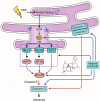Natural Products Modulate Cell Apoptosis: A Promising Way for the Treatment of Ulcerative Colitis
- PMID: 35173617
- PMCID: PMC8841338
- DOI: 10.3389/fphar.2022.806148
Natural Products Modulate Cell Apoptosis: A Promising Way for the Treatment of Ulcerative Colitis
Abstract
Ulcerative colitis (UC) is a chronic inflammatory bowel disease impacting patients' quality of life and imposing heavy societal and economic burdens. Apoptosis of intestinal epithelial cells (IECs) has been considered an early event during the onset of UC and plays a crucial role in disease development. Thus, effectively inhibiting apoptosis of IECs is of critical significance for the clinical management of UC, presenting a potential direction for the research and development of pharmacotherapeutic agents. In recent years, research on the ameliorative effects of natural products on UC through inhibiting IECs apoptosis has attracted increasing attention and made remarkable achievements in ameliorating UC. In this review, we summarized the currently available research about the anti-apoptotic effects of natural products on UC and its mechanisms involving the death-receptor mediated pathway, mitochondrial-dependent pathway, ERS-mediated pathway, MAPK-mediated pathway, NF-κB mediated pathway, P13k/Akt pathway, JAK/STAT3 pathway, and NLRP3/ASC/Caspase-1 pathway. Hopefully, this review may yield useful information about the anti-apoptotic effects of natural products on UC and their potential molecular mechanisms and provide helpful insights for further investigations.
Keywords: apoptosis; inflammatory bowel disease; intestinal epithelia cells; natural products; ulcerative colitis.
Copyright © 2022 Liu, Zeng, Wen, Huang and Liu.
Conflict of interest statement
The authors declare that the research was conducted in the absence of any commercial or financial relationships that could be construed as a potential conflict of interest.
Figures






Similar articles
-
ERK controls epithelial cell death receptor signalling and cellular FLICE-like inhibitory protein (c-FLIP) in ulcerative colitis.J Mol Med (Berl). 2013 Jul;91(7):839-49. doi: 10.1007/s00109-013-1003-7. Epub 2013 Feb 1. J Mol Med (Berl). 2013. PMID: 23371318
-
The role of the miR-21-5p-mediated inflammatory pathway in ulcerative colitis.Exp Ther Med. 2020 Feb;19(2):981-989. doi: 10.3892/etm.2019.8277. Epub 2019 Dec 4. Exp Ther Med. 2020. PMID: 32010260 Free PMC article.
-
Natural compounds target programmed cell death (PCD) signaling mechanism to treat ulcerative colitis: a review.Front Pharmacol. 2024 Feb 9;15:1333657. doi: 10.3389/fphar.2024.1333657. eCollection 2024. Front Pharmacol. 2024. PMID: 38405669 Free PMC article. Review.
-
Epithelial-specific ETS-1 (ESE1/ELF3) regulates apoptosis of intestinal epithelial cells in ulcerative colitis via accelerating NF-κB activation.Immunol Res. 2015 Jun;62(2):198-212. doi: 10.1007/s12026-015-8651-3. Immunol Res. 2015. PMID: 25926267
-
Natural products modulate NLRP3 in ulcerative colitis.Front Pharmacol. 2023 Oct 2;14:1265825. doi: 10.3389/fphar.2023.1265825. eCollection 2023. Front Pharmacol. 2023. PMID: 37849728 Free PMC article. Review.
Cited by
-
Mechanism study on the treatment of ulcerative colitis by Gegen Qinlian nano-preparation through promoting M2 macrophage polarization.Front Mol Biosci. 2025 Apr 25;12:1580874. doi: 10.3389/fmolb.2025.1580874. eCollection 2025. Front Mol Biosci. 2025. PMID: 40351533 Free PMC article.
-
Lyophyllum decastes-derived polysaccharides alleviate DSS-induced colitis in mice by suppressing inflammation, enhancing intestinal barrier integrity, and restoring gut microbiota homeostasis.Front Pharmacol. 2025 Jul 11;16:1644325. doi: 10.3389/fphar.2025.1644325. eCollection 2025. Front Pharmacol. 2025. PMID: 40717964 Free PMC article.
-
Protective role of Cecropin AD against LPS-induced intestinal mucosal injury in chickens.Front Immunol. 2023 Dec 14;14:1290182. doi: 10.3389/fimmu.2023.1290182. eCollection 2023. Front Immunol. 2023. PMID: 38162646 Free PMC article.
-
Lactobacillus fermentum 016 Alleviates Mice Colitis by Modulating Oxidative Stress, Gut Microbiota, and Microbial Metabolism.Nutrients. 2025 Jan 26;17(3):452. doi: 10.3390/nu17030452. Nutrients. 2025. PMID: 39940311 Free PMC article.
-
Lianweng Granules Alleviate Intestinal Barrier Damage via the IL-6/STAT3/PI3K/AKT Signaling Pathway with Dampness-Heat Syndrome Diarrhea.Antioxidants (Basel). 2024 May 28;13(6):661. doi: 10.3390/antiox13060661. Antioxidants (Basel). 2024. PMID: 38929100 Free PMC article.
References
-
- Adams S. M., Bornemann P. H. (2013). Ulcerative Colitis. Am. Fam. Physician 87 (10), 699–705. - PubMed
Publication types
LinkOut - more resources
Full Text Sources
Miscellaneous

